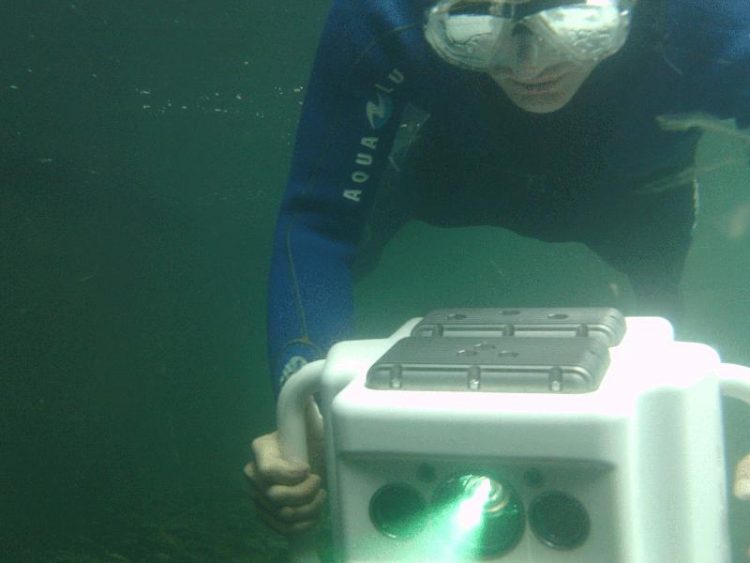Measurement of components in 3D under water

The 3D measurement system co-developed by scientists from the Fraunhofer IOF, reminds us of an underwater camera. © Fraunhofer IOF
The maintenance of underwater technical systems is elaborate and expensive. Pipes, flanges and connections of conveying systems for oil and gas at sea, for example, must first be measured for this purpose. The measurements serve to correctly assess the extent of damage – caused by corrosion, for instance, or by other defects – and to initiate suitable repair interventions.
The Fraunhofer Institute for Applied Optics and Precision Engineering IOF in Jena is presenting a system at the Hannover trade fair from April 13 to 17 (Hall 13, Booth E26), which measures underwater components and provides this information as 3D data.
The sensor and camera technology has approximately the size of a shoe box and can be held by a diver just like an underwater camera. It is currently designed for use at a water depth up to 40 meters. The prototype was created within an international research project together with the 4h JENA engineering GmbH and the Norwegian Research Institute Christian Michelsen Research (CMR).
The Thuringia Landesentwicklungsgesellschaft (state development company) was the promoter. »In the next step we want to optimize the 3D measurement system for greater depths and broader underwater application fields«, says Dr. Peter Kühmstedt, scientist at the IOF.
New 3D system: small, lightweight and extremely robust
During the project, the IOF was responsible for making 3D measurement technology suitable for underwater use. The highlight: The scientists managed to accommodate the entire control system and electronics as well as the computer and display technology in a very confined space:
»The system is no larger than 20 cubic decimeters and weighs less than 11 kilograms«, says Kühmstedt. Despite its complex technology it must still be easy to operate, because divers are limited in their movements by the water and their equipment. The researchers have adapted the operating and representation software of the system to guarantee this: Only a few buttons go outwards. The temperature is constantly monitored to keep the device mechanically and thermally stable, because under water, temperatures may fluctuate immensely depending on depth and sea current. Light conditions also differ from those on land:
There are optical refractions at the interface between the device and the water. A special calibration strategy for the measurements compensates for that. A further drawback: In the water, everything runs via wires and not via radio – therefore the scientists have to design the cables in a very compact manner.
»Under water, things are ten times more expensive. It is a large cost aspect for energy and raw material conveying companies to have their systems maintained at sea. The problem: The technologies currently available for the measurement of components are either too slow or too far away from the actual application. This is why we have developed this prototype together with the industry«, says Kühmstedt. 4h JENA engineering was responsible for the development of the housing and the system cladding, and CMR for the integration of additional sensors.
The 3D measurement system successively depicts several striped patterns onto the surface of the component to be examined by means of a projector, while at the same time taking pictures of the object are taken with two cameras. Based on the series of stereo photos taken and on the active pattern structure seen on the surface, the technology is able to exactly determine the shape of the object.
The diver needs 0.2 seconds for each 3D scan and can check under water whether they are usable. Once back on land or on the ship, he can then load the data to a computer, which evaluates the information and makes suggestions for possible repair measures. »For example it can be decided whether the rust has corroded too deeply or if the defect in the pipe presents a problem or not«, says Kühmstedt.
http://www.fraunhofer.de/en/press/research-news/2015/april/measurement-of-compon…
Media Contact
All latest news from the category: HANNOVER MESSE
Newest articles

Bringing bio-inspired robots to life
Nebraska researcher Eric Markvicka gets NSF CAREER Award to pursue manufacture of novel materials for soft robotics and stretchable electronics. Engineers are increasingly eager to develop robots that mimic the…

Bella moths use poison to attract mates
Scientists are closer to finding out how. Pyrrolizidine alkaloids are as bitter and toxic as they are hard to pronounce. They’re produced by several different types of plants and are…

AI tool creates ‘synthetic’ images of cells
…for enhanced microscopy analysis. Observing individual cells through microscopes can reveal a range of important cell biological phenomena that frequently play a role in human diseases, but the process of…





















